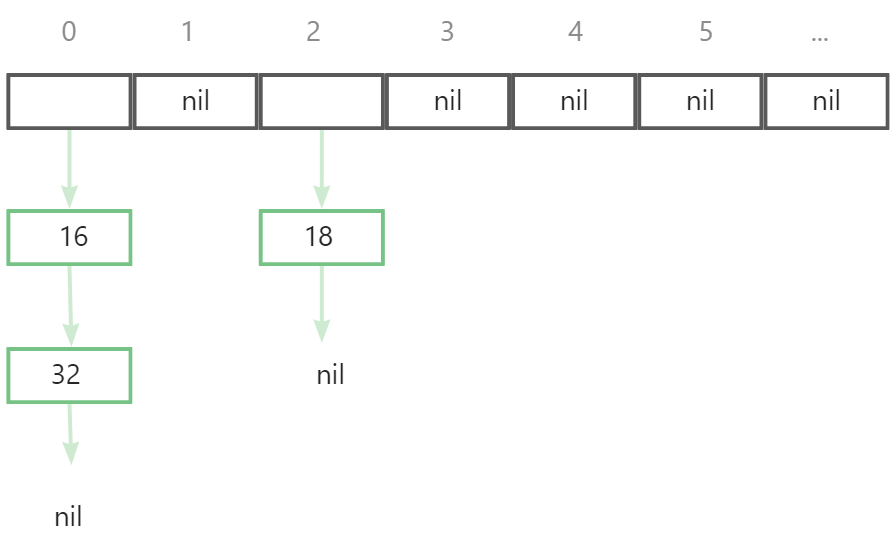简介
学过数据结构的同学可能知道,哈希(hash)是数据查询的最快方式。具有
O
(
1
)
O(1)
O(1)的时间复杂度。
原理如下:

首先需要定义一个哈希函数(又称散列函数),它的功能是把我们要存的数据x, 映射到数组上的某一个位置y。例如:
y = x ? % ? 19 y = x\ \%\ 19 y=x?%?19
这个时候会有一个问题:会有多个x映射到同一个y。假设
x
1
=
7
,
x
2
=
19
x_1 = 7, x_2 = 19
x1?=7,x2?=19, 那么它们经过上述映射后都会放在数组下标7的位置
x
1
?
%
?
19
=
7
x
2
?
%
?
19
=
7
x_1\ \%\ 19 = 7 \\ x_2\ \%\ 19 = 7
x1??%?19=7x2??%?19=7
这时就会产生冲突。解决冲突的办法有:
- 开地址法:
- 线性探测
- 二次探测
- 再哈希
- 链地址法
已有的博文对相关知识的介绍已经清晰易懂,本文不再赘述。但大多重在理论,而轻实践,示例代码多是教学性质的,无法实际用于生产环境。经过本人的观察,具有以下问题:
- 只支持单一的数据类型。实际中,我们不可能为每种类型都实现一个hashmap,
- 使用非常简单的散列函数。例如上述的取模。实际上,取模运算对整数类型的数据散列情况比较好,不支持其它类型。
本文就这两个问题进行解决,首先是使用泛型来支持任意类型,然后使用CRC64散列函数将任意二进制数据散列到64位整数再对数组长度取模。由于CRC64具有良好的散列性质,因此实现的哈希表不容易出现冲突。
原理
我们使用链地址法解决冲突。如下图:
数组中每个元素都相当于是一个链表, 当某个位置发生冲突时,直接把数据挂在链表上即可。
假设哈希表中已经有了16, 18两个数据,现在需要把32放入,经过哈希函数映后应该放在数据下标为0的位置。那把32放入链表中元素16后面即可。

在Java语言(版本1.8)中,HashMap也是使用链地址法解决冲突,当链表长度大于8时,链表将转换成红黑树。显然红黑树的平衡性质使得在红黑树上查找一个元素远快于链表。但是我认为如果能够选择一个较均匀的哈希函数,那么链表长度通常不会很长(3左右),使用红黑树提升的性能并不明显。
哈希函数有如下选择:
- DJB2 系列
- FNV 系列
- SDBM
- CRC32、CRC64
- Murmur 系列
有人已经测过这些函数的各种性能,包括碰撞率、速度、多种数据集上的分散程度:
还有一些比较新的哈希函数,如SipHash、HighwayHash、xxHash、MetroHash:
本文选择碰撞率看起来较少的CRC64。读者可根据实际性况选择。
实现
基于go 进行实现
结构
首先定义链表的结点结构。next表示下一结点,key表示用来作索引的键,value表示数据。
type _HashEntry[K comparable, V interface{}] struct {
next *_HashEntry[K, V]
key K
value V
}
接下来定义HashMap的结构。其中需要维护一个array数组,数组的数据类型为链表结点的指针。
size表示哈希表中数据的个数。
type HashMap[K comparable, V interface{}] struct {
threshhold int // 数组长度超过此阈值则扩容
inflateFactor float64 // 百分比,扩容时需要用
array []*_HashEntry[K, V] // 数组
size int // 实际数据量
}
然后是HashMap的构造函数。
初始的数组大小为16,指定当数组使用率 inflateFactor为75%时,数组需要扩容。threshhold由以下公式计算得到,为了避免多次计算下面的公式,实际是根据它来判断是否需要扩容的。
t h r e s h h o l d = l e n ( a r r a y ) × i n f l a t e F a c t o r \rm{threshhold} = len(array) \times inflateFactor threshhold=len(array)×inflateFactor
func NewHashMap[K comparable, V interface{}]() *HashMap[K, V] {
initSize := 16
return &HashMap[K, V]{
threshhold: 12,
inflateFactor: 0.75,
array: make([]*_HashEntry[K, V], initSize),
size: 0,
}
}
哈希函数
实现得比较粗暴,接直将结构体转字符串,然后字符串转二进制。再利用go自带的crc64包散列得到无符号整数。
func hash(key interface{}) uint64 {
var table = crc64.MakeTable(crc64.ECMA)
bytesBuffer := bytes.NewBuffer([]byte{})
switch key.(type) {
case string:
str := key.(string)
err := binary.Write(bytesBuffer, binary.BigEndian, []byte(str))
if err != nil {
panic("invalid key!")
}
default:
err := binary.Write(bytesBuffer, binary.BigEndian, []byte(fmt.Sprintf("%v", key)))
if err != nil {
panic("invalid key!")
}
}
return crc64.Checksum(bytesBuffer.Bytes(), table)
}
获取大小
直接返回size即可
func (this *HashMap[K, V]) Size() int {
return this.size
}
放置数据
首先利用哈希函数计算哈希值,因为是一个无符号整数,范围非常大,因此再对数组长度取模确定最终位置 index。
放入数组中的链表中后,数据量加1,如果发现数据量大小 size 大于等于threshhold, 则扩充数组。如何扩充数组,将在下面介绍。
func (this *HashMap[K, V]) Set(key K, value V) {
index := hash(key) % uint64(len(this.array))
node := &_HashEntry[K, V]{
key: key,
value: value,
}
if this.array[index] == nil {
this.array[index] = node
} else {
for i := this.array[index]; i != nil; i = i.next {
if i.key == key {
i.value = value
break
}
if i.next == nil {
i.next = node
}
}
}
this.size++
if this.size >= this.threshhold {
this.inflate()
}
}
取数据
计算得到位置后,遍历数据取出即可。
func (this *HashMap[K, V]) Get(key K) (V, bool) {
index := hash(key) % uint64(len(this.array))
if this.array[index] == nil {
return *new(V), false
}
for node := this.array[index]; node != nil; node = node.next {
if node.key == key {
return node.value, true
}
}
return *new(V), false
}
删数据
计算得到位置后,从链表中删除结点,size 减1
func (this *HashMap[K, V]) Delete(key K) {
index := hash(key) % uint64(len(this.array))
if this.array[index] == nil {
return
}
if this.array[index].key == key {
this.array[index] = this.array[index].next
this.size--
return
}
for node := this.array[index]; node.next != nil; node = node.next {
if node.next.key == key {
node.next = node.next.next
this.size--
return
}
}
}
数组扩充
当数据量大小size 到一定程度时(由inflateFactor和threshhold决定),需要扩充数组以较少哈希冲突。
这一步将重新生成一个长度为原来两倍的数组,然后遍历原数组,将所有数据重新放入新的数组中。
/*
*
扩充表格,并重新hash所有数据
*/
func (this *HashMap[K, V]) inflate() {
if len(this.array) <= (1 << 61) {
newLength := len(this.array) * 2
newThresh := int(float64(newLength) * this.inflateFactor)
oldArray := this.array
this.threshhold = newThresh
this.array = make([]*_HashEntry[K, V], newLength)
this.size = 0
// re hashing
for i := 0; i < len(oldArray); i++ {
for node := oldArray[i]; node != nil; node = node.next {
this.Set(node.key, node.value)
}
}
}
}
测试
下面代码测试了以上实现的正确性:
func TestHashMap(t *testing.T) {
m := structure.NewHashMap[int, string]()
for i := 0; i < 100; i++ {
m.Set((i), fmt.Sprint(i+100))
fmt.Println("insert: ", i)
}
m.Delete(38)
m.Delete(54)
m.Delete(86)
m.Delete(101)
m.Delete(-1)
for i := 0; i < 100; i++ {
v, ok := m.Get((i))
if ok {
fmt.Println(v)
} else {
fmt.Println("error !")
}
}
fmt.Println("size:", m.Size())
}
结果:
